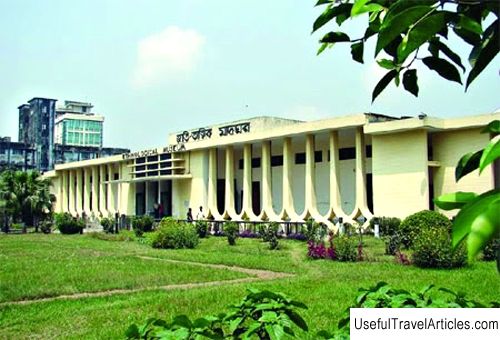Ethnological Museum + Berlin Phonogram Archives Austria, Berlin Spa
Rating: 7,6/10 (1001 votes)  Ethnological Museum – one of the world's largest ethnological museums. The exposition of the museum contains about a million exhibits of the pre-industrial period, collected at the turn of the XIX - XX by German colonialists and travelers. The Ethnological Museum is part of the State Museums of Berlin and is located in the Museum Center Berlin-Dahl. The most outstanding exhibits of the museum – These are, of course, reconstructed vehicles and dwellings of different peoples, boats, Benin bronze items, a collection of ethnic music, which includes the Berlin Archive of Phonograms, Films, a children's mini-museum and a museum for the blind. a">Berlin Ethnological Museum was founded by Adolf Bastian in 1873. Bastian was also the first director of the museum. The basis for the new museum was the art collection and the cabinet of antiquities of the Electors of Brandenburg, who later united into the Prussian Royal Kunstkamera. The ethnographic collection left the Kunstkamera in 1829. By 1885, a building was built for the collection. However, during the Second World War it was destroyed, the collection was housed in a storage building. The name `` Ethnological Museum Berlin '' the museum received it in 1999. Berlin phonogram archive – an archive of recordings of traditional music collected around the world. The phonogram archive is part of the Ethnological Museum Berlin. The collection of records began to form in 1900. By the beginning of the XXI century, the archive consisted of more than 150 thousand archival records. The records are stored on various media, including wax rollers. Many entries are included in the register `` Memory of the World '' UNESCO. The Berlin phonogram archive has a hundred-year history and it begins from the moment when scientists Karl Stumpf and Otto Abraham at the phonograph performance of a touring court musical theater from Siam. Karl Stumpf was then director of the Institute of Psychology at the Friedrich Wilhelm University of Berlin, and therefore the collection of records was housed in the building of the institute. Since 1904, the archive has been officially part of the institute. In the period from 1905 to 1933, E. M. von Hornbostel was the director of the archive, during which the archive was actively replenished with new records. Hornbostel has established cooperation with scientists-folklorists from the Museum of Ethnography, who began to give to the archive the records brought from their expositions. Also, exchange with archives of records and collectors from other countries has been established. We can say that collecting and studying the records of the archive made the discovery of a new field of science – comparative musicology The phonogram archive was part of the Institute of Psychology until 1922. Then he joined the Berlin School of Music. Since 1933, Hornbostel was forced to flee the country, Marius Schneider took his place, and the archive itself was transferred to the Museum of Ethnology in Berlin-Dahlem. During the Second World War, the main part of the archive was exported from Berlin, and after the war – sent to the Soviet Union as a war trophy. The documentation of the archive remained in West Berlin. In 1948 the trophy phonogram archive was in Leningrad and in 1949 a special committee headed by musicologist-folklorist E.V. Gippius began to study the archival records. In Leningrad, however, there were no conditions suitable for the storage and study of the archive. In addition, the information necessary for the work remained in West Berlin. Therefore, in 1958, it was decided to return the cultural values exported from the GDR. So, after the copying procedure, in 1959 the archive ends up at the Academy of Sciences in East Berlin. By 1970, it was possible to transport some of the recordings to West Berlin, copy them there and return them to East Berlin. However, the authorities of East Berlin interrupted this process and sealed the archive. In 1991, the archive's collection is merged with the surviving documentation and some records preserved in West Berlin. Records digitization begins in 1998.      We also recommend reading Emmauskirche in Austria, Berlin resort Topic: Ethnological Museum + Berlin Phonogram Archives Austria, Berlin Spa. |




